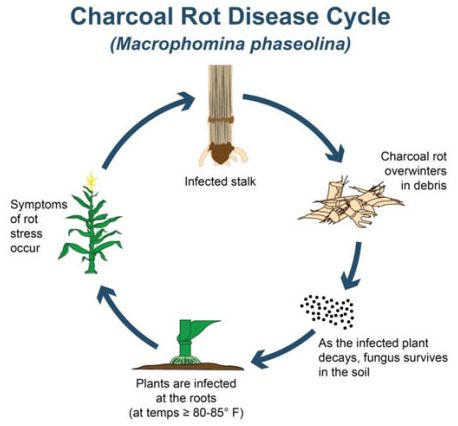Disease Facts
- Caused by the soil fungus, Macrophomia phaseolina.
- Charcoal rot begins as a root infection, which spreads into the lower stalk internodes and causes early ripening, shredding and breaking at the crown of the corn stalk.
- The very tiny black fungal bodies, known as sclerotia, on the vascular strands of the interior of the stalks, contained on the shredded pith give them a charred appearance.
- This “charring” of the interior of the stalk contributes to its namesake, as it is a distinguishing characteristic of the disease.
- The pathogen overwinters on host crop residue and survives in the soil.

- Charcoal rot survives in soil or corn residue as sclerotia, which are round, small black structures that overwinters on corn residues.
- Corn is infected during dry periods where the temperature hits 80-85 F (27-29 C). The sclerotia germinates on the root surface and penetrates the host epidermal cells of the corn.
- Traveling through the cortex, the charcoal rot will move through the xylem and colonize the vascular tissue, causing infection and a host of symptoms.
- Infected plant tissue from the previous season will decay and be released into the soil, starting the cycle over with the new growing season.
Geographic Distribution
- Macrophomia phaseolina infects more than 500 plant species and has a wide geographic distribution. It has been documented on all continents that engage in agriculture.
- In North America, it is most prevalent in the Southern U.S. and Mexico, but can develop in the U.S. Corn Belt under favorable conditions.
- In cooler, moisture abundant regions, charcoal rot is less prolific and often not present at all in climates with temperatures below 85 ºF and well-irrigated fields.
Symptoms
Symptoms and Impact on Crop
Stalk Damage and Premature Ripening
- Charcoal rot first becomes noticeable when corn is in the tassel stage or later. Upper leaves of the corn will dry out.
- Infected corn plants have shredded stalks, and the pith will have completely rotted, leaving only stringy vascular strands intact.
- The sclerotia of the fungus are small, black and spherical, and are found on and inside the vascular strands, numerous enough to give the internal stalk tissue a grey coloring.
- Translocation of water and nutrients are disrupted due to hyphae of the fungi growing intercellularly through the xylem and into the surrounding vascular tissue.
- The fungus can grow into the lower internode of the stalk as the plant matures, causing plants to ripen prematurely and weaken their stalks, causing breakage (UC Davis, 2014).
- Lodging is often caused by decomposition of stalk tissue due to infection and can result in yield loss.

The very tiny black sclerotia on the vascular strands of the shredded pith are a characteristic sign of this disease.
Environments Favoring Charcoal Rot
- Hot dry conditions: Temperatures over 85 ºF and low soil moisture favor disease proliferation. A long cold weather period followed by hot conditions will allow previously infected corn residue to be preserved on the ground over the winter, keeping the spores intact on the stalk and moving to new hosts in the spring time.
- Drought conditions: Specifically when corn is senescing, water loss causes stress on the crop that makes it highly susceptible to infection.
- Tillage practices: Populations of charcoal rot fungus will increase in the soil when the susceptible hosts are cropped in successive years and can be spread by tillage (Wylie, 1988) as the fungus can persist in the soil up to three years.
- Insect Damage and Plant Wounding: Plants with openings caused by insects or environmental damage are more susceptible to fungal infection.

Disease Management
Disease Management
- Early planting and low plant populations will decrease the competition for water and nutrients.
- Good water management: Strong irrigation practices, if available, particularly when the crop approaches the flowering stage reduce drought stress.
- The fungus does not survive well in moist soils.
- Fertility: Adequate levels of available P and K will reduce nutrient stress and encourage plant growth.
- Insect management: Controlling insect damage and wounding to the crop will help minimize potential points of infection.
- Harvest early: Harvest when the crop is mature (30% moisture content) as delayed harvesting can result in extensive crop loss due to lodging (White, 1999).
- Crop rotation: Rotation to a non-host crop, such as small grains can help reduce the disease potential.
- Many crops are host to this disease besides corn, including soybean, grain sorghum, sunflowers and other weed hosts.
- Non-host crops are cereal grains such as wheat, oats, rice, barley and rye.
- Rotation out of a host crop for three years may effectively reduce fungal spore numbers in severe infestations.
- Residue management: Reduced tillage may help conserve moisture but also distribute infected plant debris and soil containing fungal spores.
- Management practices that promote crop residue decomposition may help decrease the population of the fungus in the soil.
- Hybrid selection: Use hybrids resistant to Diplodia and Gibberella stalk rot, as these tend to offer genetic resistance to charcoal stalk rot as well.
Author: Nanticha Lutt, Agronomy Sciences Intern
The foregoing is provided for informational use only. Please contact your Pioneer sales professional for information and suggestions specific to your operation. Product performance is variable and depends on many factors such as moisture and heat stress, soil type, management practices and environmental stress as well as disease and pest pressures. Individual results may vary.